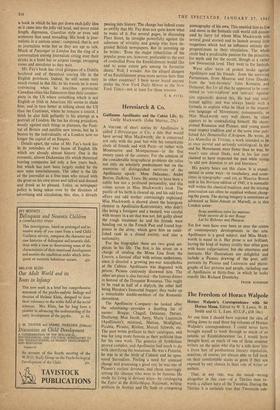Heresiarch & Co.
Guillaume Apollinaire and the Cubist Life. By Cecily Mackworth. (John Murray, 25s.) A VOLUME of short stories by Apollinaire is called L'Heresiarque et Cie, a title that would have served Miss Mackworth; she is concerned not only with the poet but with his remarkable circle of friends and with Paris--or rather with Montmartre and Montparnasse—in the first twenty years of the century. For the solution of the considerable biographical problems she relies not only on scholarly predecessors but on the memories of distinguished survivors of the Apollinaire epoch : Mme Delaunay, Andre Breton, Zadkine, Tzara. He seems to have been a subtle but not a profound personality, and this comes across in Miss Mackworth's book. The puzzle of his birth is cleared up, and his odd love affairs and odd mother convincingly explained. Miss Mackworth is shrewd about the bourgeois element in Apollinaire-Kostrowitsky, who didn't like being a foreigner and a bastard, was careful with money in a set that was not, felt guilty about the rough treatment he and his friends were handing out to the French Past and found hap- piness in the army, which gave him an estab- lished rank in a closed society, and also a nationality.
For the biographer there are two great set- pieces in his life. The first is his arrest on a charge of stealing the Mona Lisa from the Louvre, a farcical affair with serious undertones, since it directed a growing pre-war xenophobia at the Cubists. Apollinaire was disgusted with prison; Picasso cautiously disowned him. The other set-piece is also farcical—the famous dinner in honour of the Douanier Rousseau. This ought to be read as half of a diptych, the other half being Haydon's Immortal Supper; they make up a remarkable double-emblem of the Romantic movement.
The Apollinaire Company—he looked after the advertising—provides a dazzling list of names: Braque, Chagall, Delaunay, Derain, Duchamp, Max Jacob, Jarry, Marie Laurencin (Apollinaire's mistress), Matisse, Modigliani, Picabia, Picasso, Riviere, Marcel Schwob, etc. The poet wrote prefaces to their catalogues, and was for long more famous as their publicist than for his own work. The genetics of Symbolism proved complex, and Apollinaire had much to do with identifying the mutations. He was a Futurist,
he was in at the birth of Cubism and he spon- sored Surrealism. Feeling a need for constant change and possessing a good eye, he was one of
Picasso's earliest devotees, and chose unerringly among the obscure who were .to be famous, He
made his living in devious ways—by cataloguing the Enter at the Bibliothaque Nationale, writing prefaces to Aretino and De Sade or composing pornography of his own. This enabled him to live and move in the fantastic café world still domin- ated by Jarry (of whom Miss Mackworth tells several good stories) and to launch several little magazines which had an influence entirely dis- proportionate to their circulation. The whole circle had a predictable passion for the primitive, for myth and for the occult, though at a rather low Sweeneyish level. They went in for hashish.
Wave after wave of protest broke against Apollinaire and his friends: from the surviving Parnassians, from Maurras and Leon Daudet. from the 'anti-hermetic' Jules Romains and Duhamel. But for all that he appeared to be com- mitted to 'anti-tradition' and 'anti-art' Apollin- aire repeatedly denied this. He had real intel- lectual agility, and was always handy with a formula to explain what he liked in the impres- sive language of Movements; consequently, as Miss Mack worth very well shows, he often appears to be contradicting himself. He cham- pioned Rousseau and Picasso; said young poets must respect tradition and at the same time pub- licised Les Demoiselles d'Avignon. He wrote, in Les Mamelles de Tiresias, a work intended to be at once surreal and seriously sociological. In the end his Movements were faster than he was; he wasn't sure about Dada, and in his last year claimed to have respected the past while trying `to add new domains to art and literature.'
His poetry bears out this claim. It is experi- mental in some ways—in vocabulary, and some- times in typography—and yet, as Maurice Bowra said in his Horizon edition of 1945, it is normally well within the classical tradition, and the missing punctuation can often be supplied without chang- ing the poem. The daring imagery is sometimes as advanced as Saint-Amant or Marvell, as in this London scene:
Nous semblions entre les maisons Onde ouverte de la mer Rouge Lui les fiebreux moi Pharaon.
Yet few men have ever been so near the centre of contemporary developments in the arts. Apollinaire is a good subject, and Miss Matk- worth is equal to it. Her prose is not brilliant, having the kind of watery civility that often goes with haute vulgarisation; but she entertains and instructs. Her illustrations are delightful and include a Picasso drawing of the poet, self- portraits by Picasso and Laurencin and photo- graphs of key pictures and people, including one of Apollinaire at thirty-four, in which he looks exactly like Richard Dimbleby.










































 Previous page
Previous page